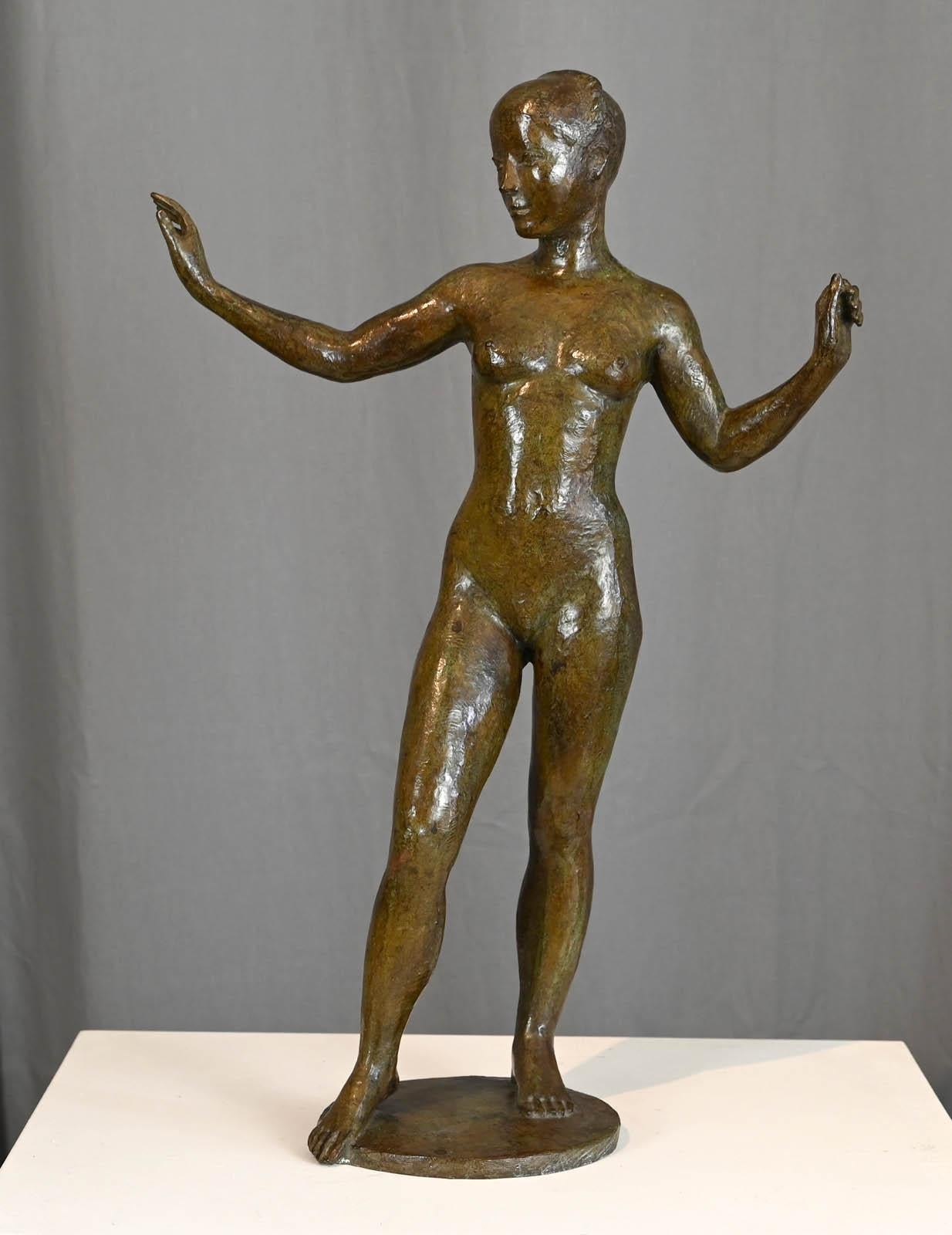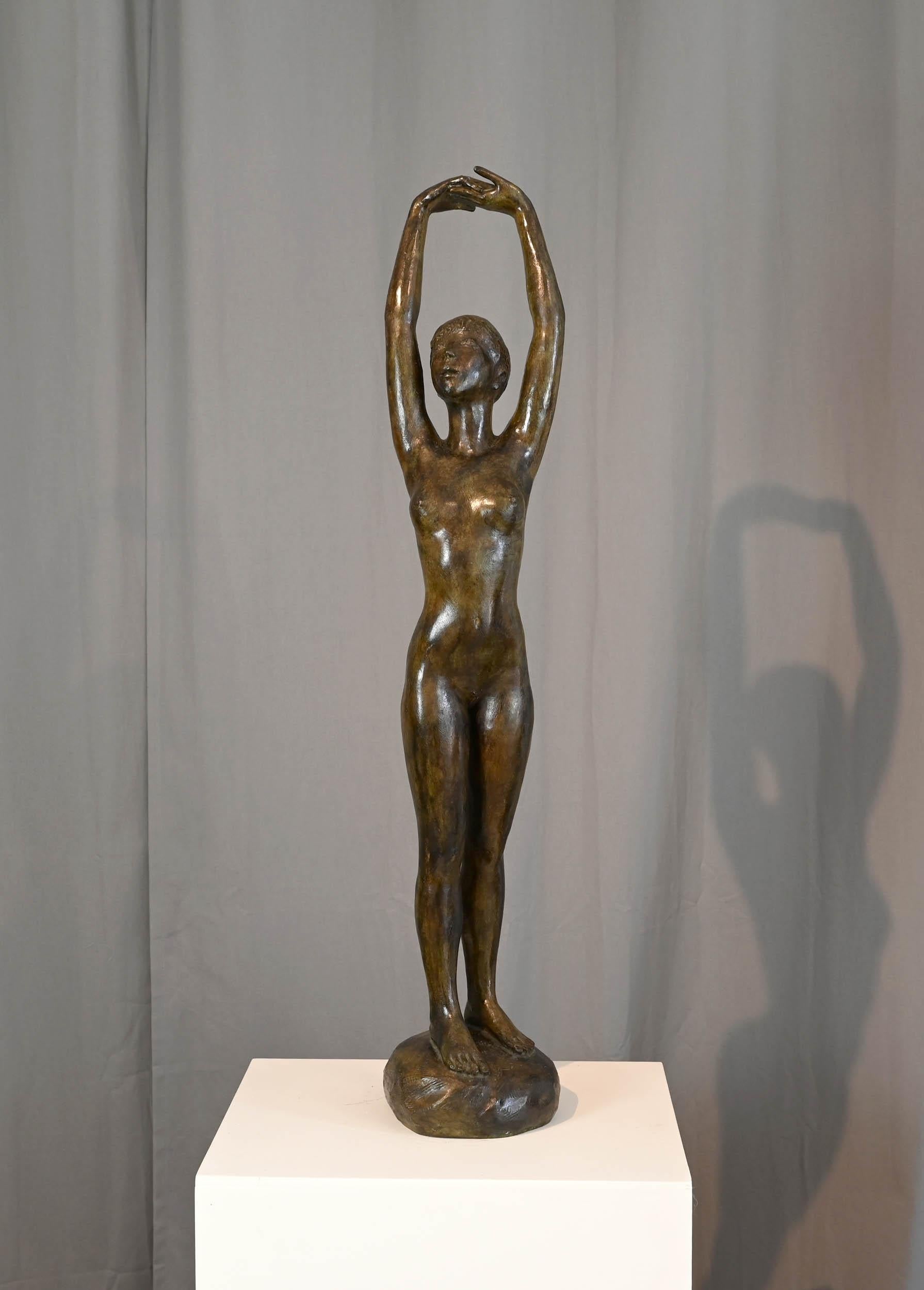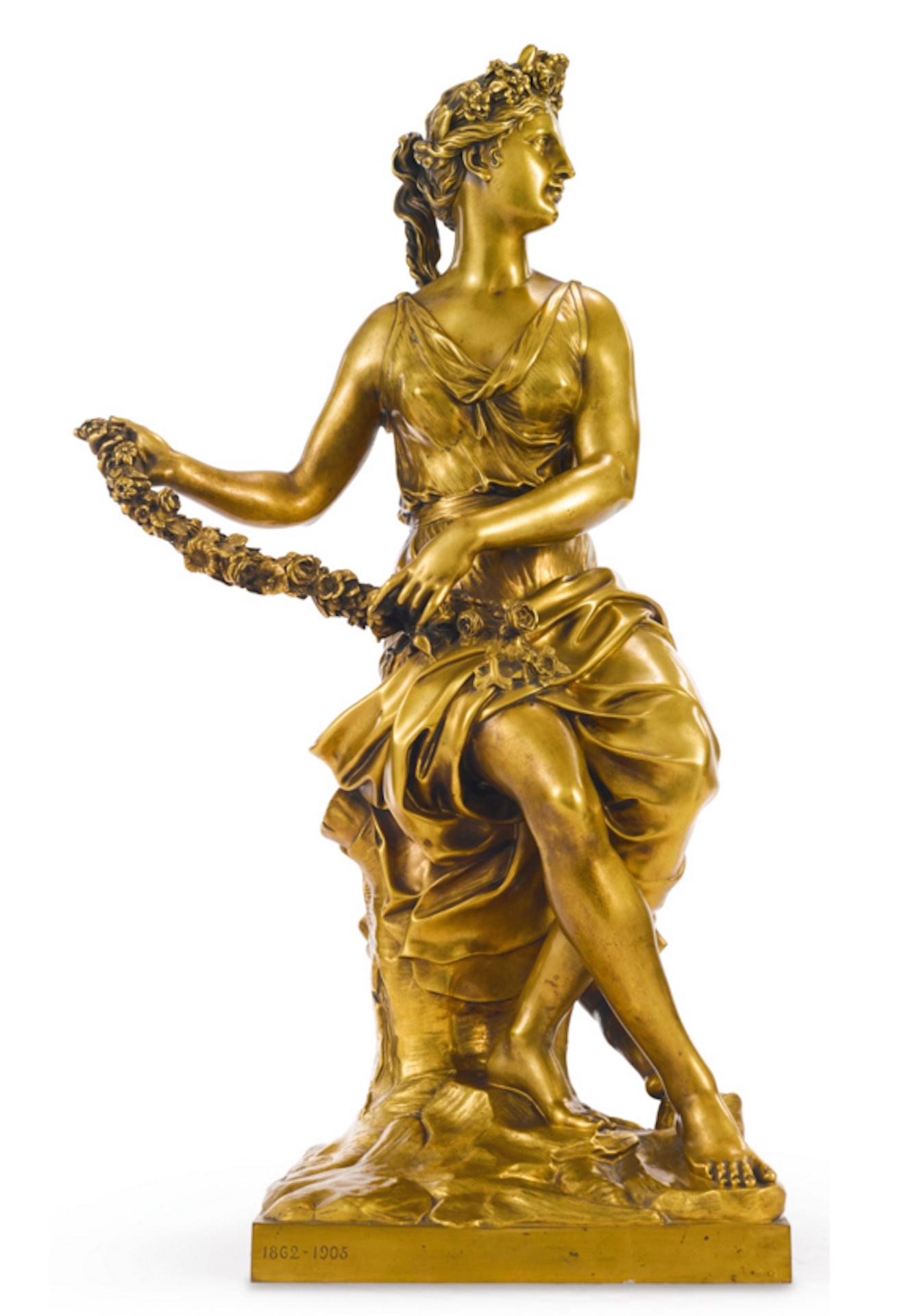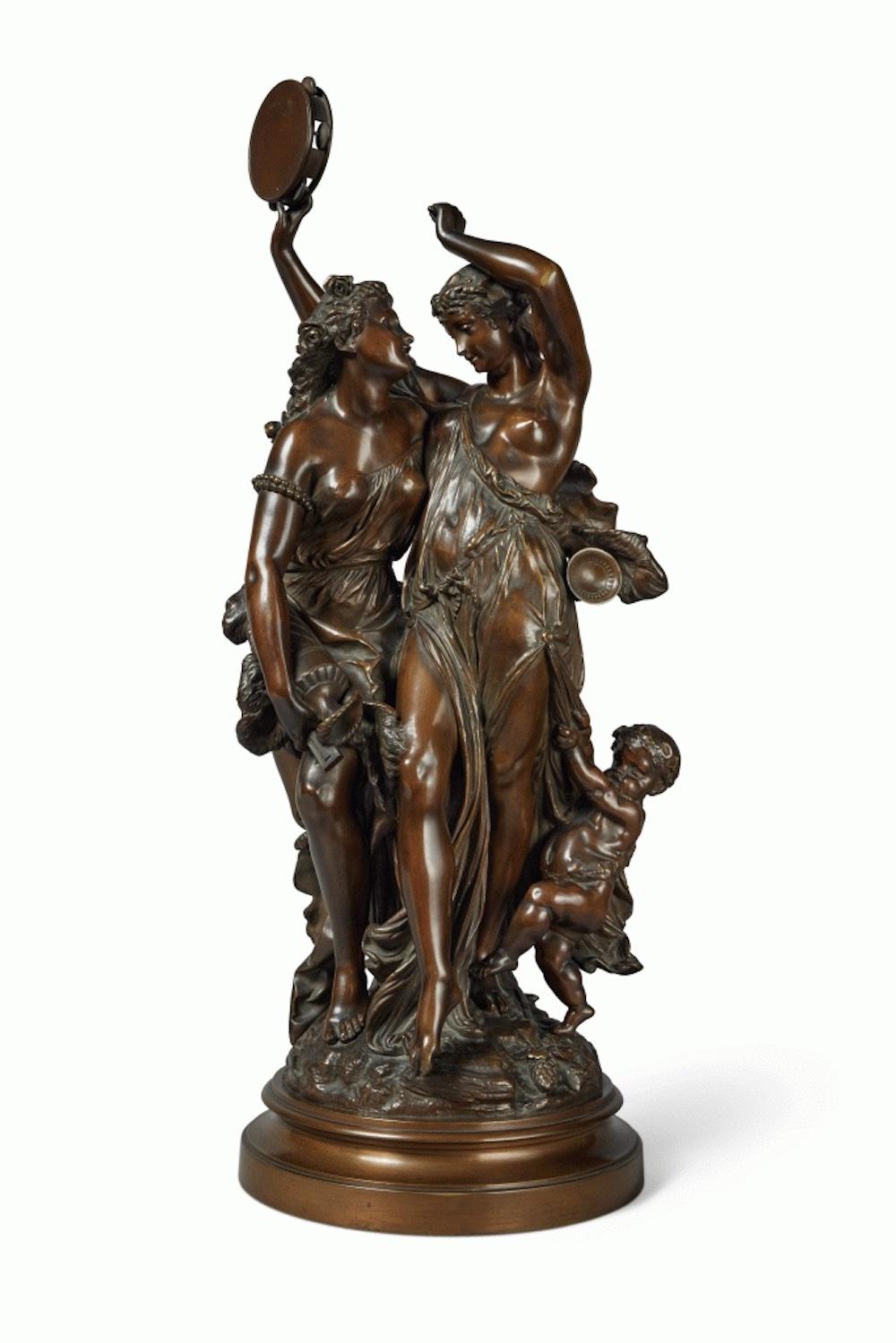Items Similar to Seated Woman Bronze, Femme Assise a la Toiletter or Petite Baigneuse Assise
Want more images or videos?
Request additional images or videos from the seller
1 of 6
Richard GuinoSeated Woman Bronze, Femme Assise a la Toiletter or Petite Baigneuse Assise1915
1915
About the Item
A recent show in 2023- 2024 of Richard Guino's work was a beautiful survey showing his work, and the work of Senior, are almost interchangeable. This exhibit in Perpignan France showed his sketches and drawings which were often studies for the sculpture, as the one shown here, as well as for further paintings.
Richard Guino was born in Gerona Spain in 1880. He attended Fine Arts class at the Ecole des Beaux Arts in Barcelona. IN 1908 Maillol discovered him at a group exhibit in Gerona. He began to work with Maillol at his studio and collaborated int the develpment of the "Four Seasons". He then worked with Maurice Denis on 2 bas reliefs for the new theatre at the Champs Elysees. In 1913 he met with Vollard at the Druet Gallery in Paris, and Vollard, convinced of the great talent of Guino propsed him to Renoir as an assistant. A veritable osmosis was created between the two and Renoir began to choose the subjects, the people their gestures, and Guino modeled and molded the clay to create the sculptures. Together they produced some 20-30 sculptures. In 1918 Guino left the studio of Renoir and began to exhibit with Galerie Hebard in Paris where he had three exhibitions.
The two dimensional works of Pierre Auguste Renoir are among the best known and best loved works in all art history. In museums or in coffee table art books much of the world is familiar with the sensual colors and forms of his paintings, drawings and lithographs.
However, because of a series of unusual circumstances, the sculptures of Renoir are little known except by the experts. And though these experts generally regard the sculptures of Renoir are among the best examples of the classical French tradition, there are several reasons they are relatively unknown. One reason is that Renoir created very few sculptures, and the examples of these works are in the major museums in the world. Furthermore, the sculptures of Renoir have been surrounded in mystery since their creation some 70 years ago.
Before 1918, Renoir had created only one sculpture (a small medallion depicting his young son, Coco), and by that time, a crippling rheumatism had reduced his hands to more than claws so he was completely unable to manipulate the raw material of sculpture in order to realize the visions which still richly filled his imagination. By a happy coincidence, Renoir’s dealer Vollard introduced him to a young Spanish sculptor, Richard Guino, who was considered by his mentor, Aristide Maillol, to be the most talented student of sculpture in Europe.
For four years, Renoir and Guino lived together in Renoir’s home in Cagnes and Essoyes and discovered they had a collaboration that has been described as nothing short of miraculous. If was is if by osmosis the old mater’s visions flew through the air and lodged themselves in the brain, and heart, and most importantly the hands of the young Spanish genius. The resultant works are a marvelous bi-product of a collaboration perhaps unparalleled in the history of art.
No one could see these fabulous bronzes and believe they were not from the mind of Renoir. Yet we are certain that the fingers of Renoir were so paralyzed as to have made their execution impossible for him.
The mystery began after the collaboration ended in 1918-1918. Ambroise Vollard, perhaps feeling that the market place in those years would have difficulty comprehending the nature of the relationship between Renoir and Guino, totally suppressed the role of Guino in the creation of these works. Therefore, for many years, the only hint of a collaboration was the mention, almost parenthetically, of an unnamed “assistant” who helped Renoir with some of the more physically demanding aspects of the creation of his bronze sculptures.
As Guino grew old and continued to sculpt, paint and draw in relative obscurity, certain champions, including his son Michael, beseeched him to attempt to set the record straight. Finally after being approached by Renoir’s heirs in the 1960s to allow certain molds which he had created some of these masterpieces decades before to be recast, Richard Guino realized that yet more of his collaborative work with Renoir was going to be presented to the world marketplace without his part in the creation being known, and he finally decided to seek to redress the scales.
He sued the Renoir estate in 1969 and over the next 14 years, the French legal system analyzed the evidence from every angle, interviewed hundreds of current artists, sought evidence from personal recollections of the creative process, and read through correspondence related to those years. After a series of appeals were exhausted by the Renoir family, the decision stood: Richard Guino and Pierre Renoir were co-authors of the vast majority of that grouping of sculptures which had previously been recognized around the world as Renoir’s alone. The court also took note of the lack of control of the castings of some of the sculptures which had existed for some time, and ordered that the original molds be placed in the joint custody of the Renoir and Guino heirs for the creation of a final small group of castings, after which it ordered the original molds be given in perpetuity to national museums. Of course, the proceeds of this last group of castings was to go primarily to the Richard Guino estate. Guino himself had died in 1973.
Currently there is a solo exhibition of the work of Richard Guino in Perpignan France. His work remains in the permanent collection of major Museums worldwide along side his collaborator August Renoir.
Lynda Anderson Gallery has a large selection of his drawings, many of which are studies for sculptures to be executed by both Renoir and Guino as collaborative works of art.
- Creator:Richard Guino (1880 - 1973, French)
- Creation Year:1915
- Dimensions:Height: 8 in (20.32 cm)Width: 5 in (12.7 cm)Depth: 6 in (15.24 cm)
- Medium:
- Movement & Style:
- Period:
- Condition:
- Gallery Location:Brookville, NY
- Reference Number:1stDibs: LU1635213239822
About the Seller
5.0
Gold Seller
These expertly vetted sellers are highly rated and consistently exceed customer expectations.
Established in 1985
1stDibs seller since 2021
11 sales on 1stDibs
Typical response time: 1 hour
- ShippingRetrieving quote...Ships From: Brookville, NY
- Return PolicyA return for this item may be initiated within 3 days of delivery.
More From This SellerView All
- Troublemaker, Bolting Horse without RiderLocated in Brookville, NYKathleen Friedenberg began her professional career as a veterinary surgeon in England, and came to the United States, on a Thouron scholarship, studying human and equine orthopaedics...Category
Early 2000s American Realist Figurative Sculptures
MaterialsBronze
- Sculpture of a Polo Player Harrison Tweed by Charles RumseyBy Charles Cary RumseyLocated in Brookville, NYPolo Pony and Rider Harrison Tweed . Charles Rumsey was an 8 goal polo player with Meadowbrook Polo Club on Long Island NY. He was an avid sportsman, equestrian and artist. His ab...Category
1910s Abstract Impressionist Figurative Sculptures
MaterialsBronze
- Bronze Cat Swatting a Fly "The Fly"Located in Brookville, NYKathleen Friedenberg began her professional career as a veterinary surgeon in England, and came to the United States, on a Thouron Scholarship, studying human and equine orthopedics ...Category
Early 2000s American Realist Figurative Sculptures
MaterialsBronze
- Jockey Pipe Rack in Bronze A Bronze by Charles RumseyBy Charles Cary RumseyLocated in Brookville, NYCharles Rumsey was a child prodigy sent to Paris to train in sculpting at age 12. He was not only a prodigy sculptor but an avid horseman and sportsman...Category
1910s American Impressionist Figurative Sculptures
MaterialsBronze
- "Ground Zero" Bronze German Shepherd Dog Searching for SurvivorsLocated in Brookville, NYThis sculptor is not only an artist, but a vetrinarian. She knows anatomy as well as she knows breeds and behaviors.. This beautiful bronze depicts a German Shepherd Dog searching ...Category
Early 2000s Realist Figurative Sculptures
MaterialsBronze
- Dog Scratching Bronze of a Dog ScratchingBy Charles RumseyLocated in Brookville, NYCharles Cary Rumsey attended Harvard University, studied art in Paris at the Academie Julian and at Boston School of Fine Art under Bela Pratt. His public works are found worldwide, such as the frieze at the Manhattan Bridge, Zion Park...Category
1910s American Realist Figurative Sculptures
MaterialsBronze
You May Also Like
- VictoireLocated in LE HAVRE, FRJacques COQUILLAY (né en 1935) Victoire Original bronze Size : 105 x 22 x 20 cm Copy No. 1/8 Signature and numbered on the base. Original bronze made with “lost wax” The edition o...Category
Early 2000s French School Nude Sculptures
MaterialsBronze
- MarieLocated in LE HAVRE, FRJacques COQUILLAY (né en 1935) Marie Original bronze Size : 56x39x17cm Copy No. 4/8 Signature and numbered on the base. Original bronze made with “lost wax” The edition of the bro...Category
Early 2000s French School Nude Sculptures
MaterialsBronze
- Flora et L'amour ou HamadryadeBy Ferdinand BarbedienneLocated in Tallinn, EEFerdinand Barbedienne (1810 - 1892) Antoine Coysevox, after (France, 1640-1720) Flora et L'amour ou Hamadryade Inscribed 'A. COYSEVOX. F. 1710'. With foundry mark 'F. BARBEDIENNE...Category
Late 19th Century French School Figurative Sculptures
MaterialsBronze
- Danse au TambourinBy Albert-Ernest Carrier-BelleuseLocated in Tallinn, EEAlbert-Ernest Carrier-Belleuse 1824 - 1887 Danse au Tambourin signed Carrier Belleuse bronze height: 72.4cm. diameter: 26.7cm. Provenance Important American collection. The present ...Category
Mid-19th Century French School Figurative Sculptures
MaterialsBronze
- Hay BalerBy Aimé-Jules DalouLocated in PARIS, FRThis Hay baler is a subject that is included in the famous suite commonly called "little workers" by Jules Dalou (1838-1902) Bronze with dark brown patina c...Category
Late 19th Century French School Figurative Sculptures
MaterialsBronze
- Bearer of wheat sheavesBy Aimé-Jules DalouLocated in PARIS, FRThis bearer of sheave is a subject that is included in the famous suite commonly called "little workers" by Jules Dalou (1838-1902) Bronze with dark brown patina cast by Susse Frère...Category
Late 19th Century French School Figurative Sculptures
MaterialsBronze



